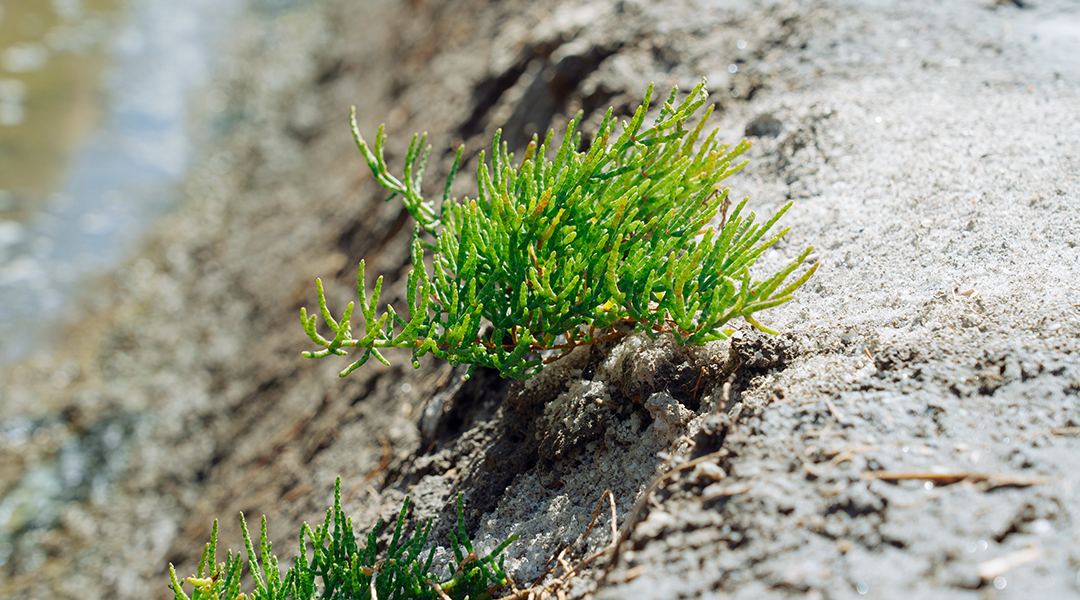Robots have received some bad press for replacing humans in industries such as manufacturing and transportation, but some jobs truly are better suited for our mechanical, computerized counterparts.
In theory, robots could take over dangerous tasks, such as fire rescue, deep sea exploration, and certain military operations, but before that can happen, robots and the human-machine interfaces that sometimes control them will have to become a lot tougher.
Researchers at Nanjing University of Science and Technology and Nanjing University of Posts & Telecommunications in China are taking some early steps toward this goal, thanks to a plant genus called Salicornia — succulents that thrive on beaches and in salt marshes and can be found in a range of climates from subtropical to subarctic. They’re commonly called pickleweed, glasswort, or sea asparagus; they’re edible, but they’re also salt-tolerant, drought-tolerant, and cold-tolerant.
The researchers say Salicornia inspired the design of a conductive hydrogel that is stronger than natural rubbers and adapted for extreme environments.
Lessons from the plant world
Conductive hydrogels are gels with electrical properties that can be used to build flexible, wearable sensors for human-machine interfaces. When attached to human skin, these sensors can monitor the electrical signals generated by muscle movements, then transmit the signals to a robot’s control module so it can use the information to copy a person’s movements.
But conductive hydrogels have some practical problems — they tend to be mechanically weak, for example, and they can’t withstand extreme temperatures. Past research has attempted to solve these problems with chemicals like propylene or ethylene glycol, which can help improve the hydrogel’s performance in a wider range of temperatures.
Jian Niu, one of the researchers who worked on the study, says propylene and ethylene glycol aren’t good alternatives. “Propylene or ethylene glycol toxicity can be a problem in scenarios where there is accidental ingestion or prolonged exposure to these chemicals,” he said. “These chemicals can cause adverse health effects [at high doses], including kidney damage, central nervous system depression, and even death.”
The researchers proposed alternative is a hydrogel inspired by Salicornia. Niu says Salicornia has a “unique ability to accumulate a large amount of salt ions from the surrounding environment and store them between cell walls.” It also has tough, flexible stems, characteristics the researchers wanted to emulate. To give their hydrogel similar properties, they immersed it in a saltwater solution.
“After the soaking treatment, the […] hydrogel can significantly reduce the freezing point of the gel, preventing water from freezing,” said Niu. The saltwater solution also helps the hydrogel retain water, which prevents water loss in extremely cold conditions. It’s heat tolerant, too — researchers say sensors made from their hydrogel will still perform well at temperatures as high as 80˚C (176˚ F).
Not just for extreme environments, benefits in healthcare too
A tough hydrogel could solve some of the problems presented by common gel-based wearable sensors, which aren’t always strong enough to withstand the motion of major human joints, such as knees and elbows.
“Such materials could be very useful for the prosthetic devices mimicking the cartilage properties and functions,” said Stephan Rudykh, an assistant professor at the College of Engineering at the University of Wisconsin-Madison, who was not involved in the study. Rudykh also says the temperature tolerance of the hydrogel could increase the range of conditions that robots can operate in.
Niu says the toughness and heat/cold tolerance of the hydrogel gives it a broad range of applications from fire rescue to military operations.
“In extreme expeditions or missions, utilizing human-machine interaction can leverage the expertise and skills of the explorers while mitigating unknown risks they may face,” he said. Other applications could include “polar exploration, cold region engineering, and low-temperature medical applications,” he added.
Tough, temperature-tolerant hydrogels are just a small piece of the work that will need to be done before robot soldiers and firefighters will become commonplace, but they are a promising early step into making human-machine interfaces more robust and dangerous jobs less dangerous.
Reference: J. Niu, et al., Bio-Inspired Conductive Hydrogels with High Toughness and Ultra-Stability as Wearable Human-Machine Interfaces for all Climates, Macromolecular Rapid Communications (2023). DOI: 10.1002/marc.202300324
Feature image credit: Onda Colossal on Unsplash

















